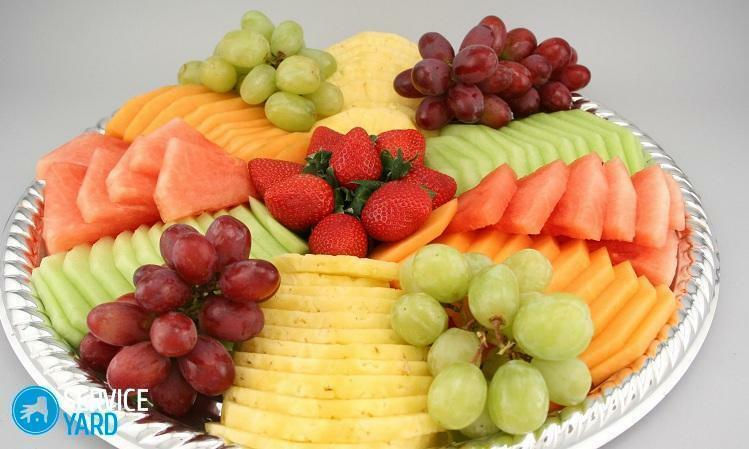Garden purslane (portulaca) is a striking representative of a useful plant that brings beauty to the site. A multi-colored mixture of bright inflorescences is used to decorate flower beds, mixborders, alpine slides and decorate houses.
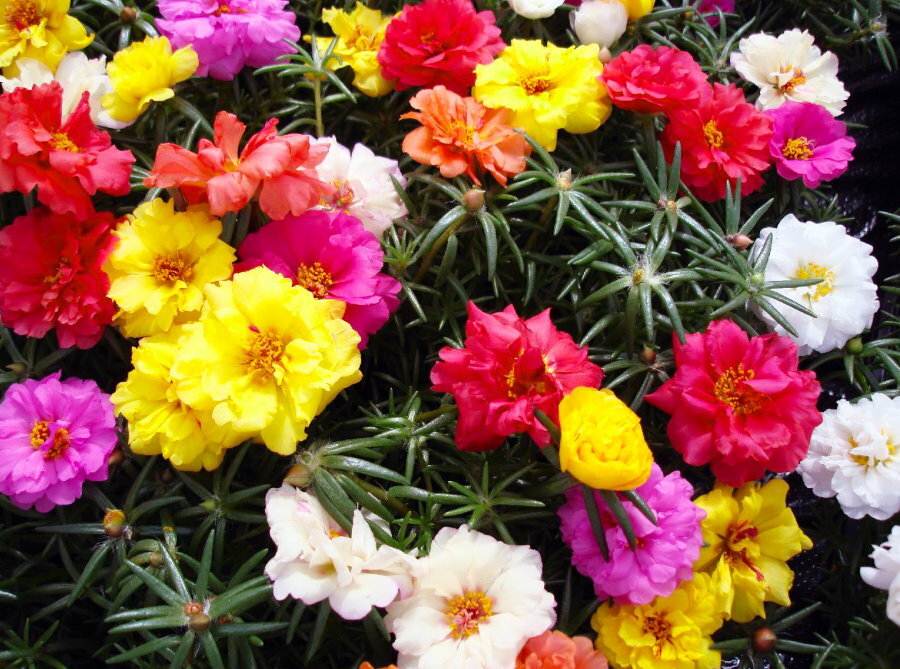
Purslane has long conquered gardeners with its beauty and amazing unpretentiousness.
Landscaping with a purslane is not only beautiful, but also useful
Content
- Landscaping with a purslane is not only beautiful, but also useful
- The use of a plant in landscape design
- Common types of purslane
- Large-flowered
- Garden
- White-flowered
- Recommendations for reproduction, planting and care
- Landing
- Care and reproduction
- Video: Growing and caring for purslane
- Photo of garden compositions in a flowerbed with other flowers
Gardeners who know this herb use it in salads and soups all summer long, and prepare it for the winter in the form of pickles and marinades. The original taste and aroma of the plant gives meat, fish dishes and salads a subtle "sour" taste. Purslane is often used as an additive in vegetable salads for strict diets to replenish protein and trace elements in the body.

Vegetable purslane is often added to Greek salad as a refreshing touch.
The leaves and young shoots of purslane are rich in proteins that normalize digestion, vitamins PP, C, E, carotene that increase vitality. Cutting a thick leaf in half and applying it to a wound, pimple or wart, you can forget about pain and inflammation. Purslane helps with kidney and liver diseases, lowers blood sugar and normalizes sleep.

Purslane leaves and stems contain easily digestible vitamins and minerals
Purslane must be used with caution: with increased pressure, people with heart rhythm disturbances and increased nervous excitability, but in small doses it is useful to everyone.
And by looking at the photo of the plant, the garden purslane, you can make sure that it will not only bring health benefits, but also become a decoration of the garden.

Purslane flowers come in different tones - red, white, yellow, pink, there are even variegated colors
The use of a plant in landscape design
Flowers will adorn the site from May to October. In the middle lane, purslane is grown as an annual plant, it is extremely thermophilic, and in the southern regions it grows in one place for 3-4 years, then the planting must be renewed.

Purslane thrives even on poor sandy soils
The plant is 15-30 cm tall and has thick, fleshy leaves that are bright green or gray and red.
The variety of foliage and flowers allows you to use it in different combinations with other plants and plant it as an independent decoration of flower beds.
A rich color palette in the form of simple or double petals will decorate any garden.

Large-flowered purslane is excellent for growing in hanging pots, containers and flowerpots
The use of purslane in landscape design:
- Low-growing and bright flowers look good in a cascading flower arrangement in the foreground.
- Planted flowers along the curbs along the paths and at the delimitation of zones on the site.
- They are in perfect harmony with stones in the design of alpine slides and waterfalls.
- Used in a separate flower bed as a bright floral rug, with the simultaneous planting of several types of plants.
- Feel good in pots and hanging planters when decorating home and recreation areas.
Purslane goes well with early flowering daffodils and tulips, perennial hosts, phlox and ornamental grasses and cereals in compositions.

Purslane can be used to form a whole floral carpet.
Common types of purslane
The diverse world of purslane includes more than a hundred species and subspecies of this plant. The plant has different foliage: thin, bright green, fleshy leaves with a gray bloom and a red tint in a varied color palette during flowering.

Splendens variety with unusually bright purple-pink petals

Sunglo variety with large fleshy shoots and large pink flowers
Large-flowered
Creeping plant with small fleshy leaves up to 30 cm high and large flowers of five petals or double inflorescences up to 3 cm in diameter. The large-flowered species has a rich palette of colors: white, yellow and red with different shades.

A native of South America, the large-flowered purslane is a perennial creeping plant. In our country, it is grown as an annual
The plant is edible, young shoots and leaves are eaten, but it is mainly used in landscape design. They are decorated with alpine slides in gardens and stone curbs in city parks and alleys, often grown in containers and hanging pots on balconies.
Common varieties are Cherry, Pun and Flamenco.
Garden
Annual plant 15-30 cm tall, with a thick tubular stem, fleshy leaves and white, yellow, beige and light brown flowers. In the gardens of the southern regions, it is grown as a medicinal plant, it often grows along the banks of rivers in rocky areas and reproduces by self-seeding.

Garden purslane is cultivated all over the world
Garden purslane blooms from June to August, and begins to bear fruit in mid-September. Fruits and stems are rich in fatty organic acids, macro and microelements, vitamins, which is a natural antioxidant.
Common varieties: Macovei, Paradox and Firefly.
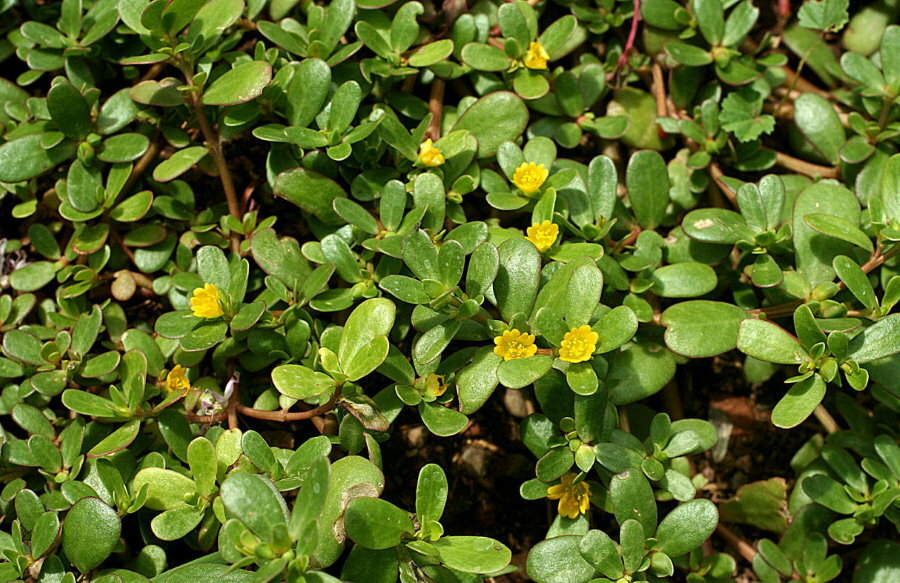
In comparison with other species, the garden purslane blooms rather inconspicuously, but after all, it is also grown as a medicinal plant.
The common purslane garden in the photo looks like an original ornamental plant with a beautiful flowering.
White-flowered
Shrub fast-growing variety of purslane species. A bush 40 cm in diameter grows in a month and begins to bloom. A distinctive feature of the white-flowered species: a large terry inflorescence of white or with a creamy and yellowish tint. Bushes are planted in flower beds as part of compositions or a stand-alone plant.

The variety is distinguished by chic white double flowers.
After looking at a photo of a purslane in a flower bed, it is difficult to refuse this flower in your collection.
Recommendations for reproduction, planting and care
Purslane is a plant that loves warmth and sun. When blooming, the buds close at night and open again with the first rays of the sun.

To achieve abundant flowering of purslane, it must be planted in the most lighted place.
Landing
Flowers are grown in seedlings by sowing in boxes from mid-April on the windowsill. Drainage, loose nutritious soil are poured into the boxes and seeds are sown to a depth of 0.5-1 cm. The sprouts will appear in three to four days at a temperature of +25 degrees. Boxes with shoots must be installed on a window on the sunny side of the house, otherwise the shoots will stretch out and die.

It is better to plant purslane seeds not in peat soil, but in a mixture of garden soil with sand in a ratio of 1: 5
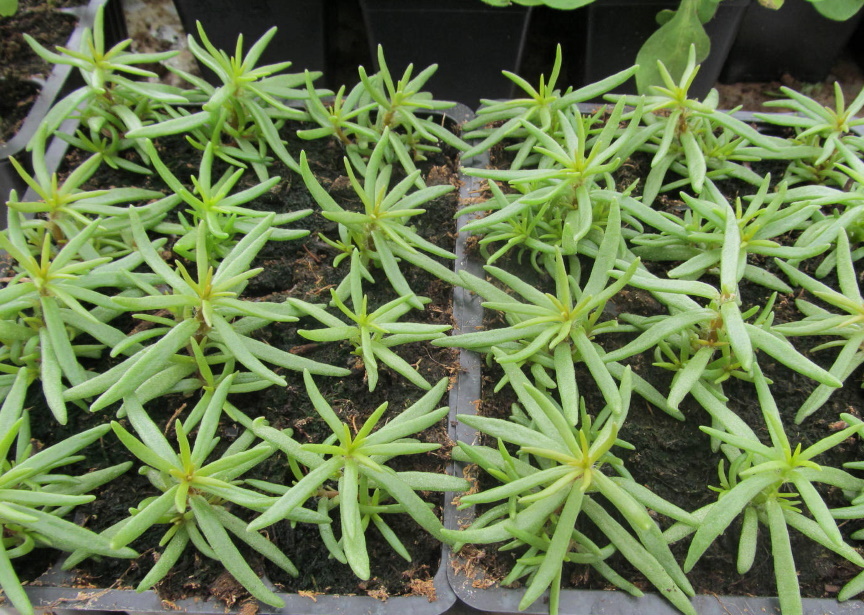
When the seedlings get real leaves, they are dived into small pots.

Purslane is grown in separate containers until transplanted into open ground
Purslane is planted in flower beds in May for the southern regions and in mid-June for the middle zone. A creeping plant needs space in the garden, so it is planted at a distance of 15 cm from each other and covered with insulation materials, which are removed at temperatures above + 20 degrees.

When planting a purslane in open ground, maintain the distance between seedlings
Care and reproduction
Purslane does not require special care, the plant in natural conditions often lives on rocky terrain and feels great in drought.
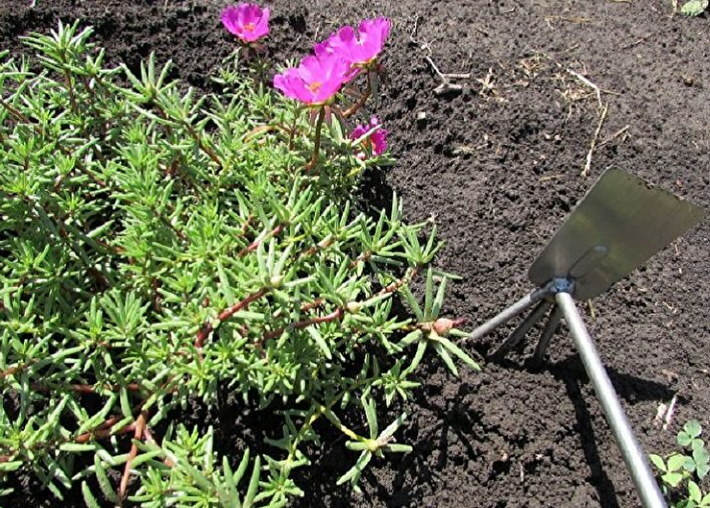
Around young seedlings, it is necessary to loosen the soil after watering

Grown plants need regular, but not very frequent watering - every 4-5 days with warm water
During the flowering period, the plant can attack aphids and thrips, it will be necessary to spray the bushes with special means, but in general, the purslane is unpretentious.
When planting a plant in open ground, it is advisable to fertilize poor soil with nitrogen fertilizers. In dry weather, purslane is watered once a week, at the rate of 10 liters of water for 3-4 bushes, preferably under the root, delicate leaves are sensitive to sunburn.
The seeds are harvested at the end of September, when the purslane fades and the seed pods turn brown. Dry at home and ready to plant.
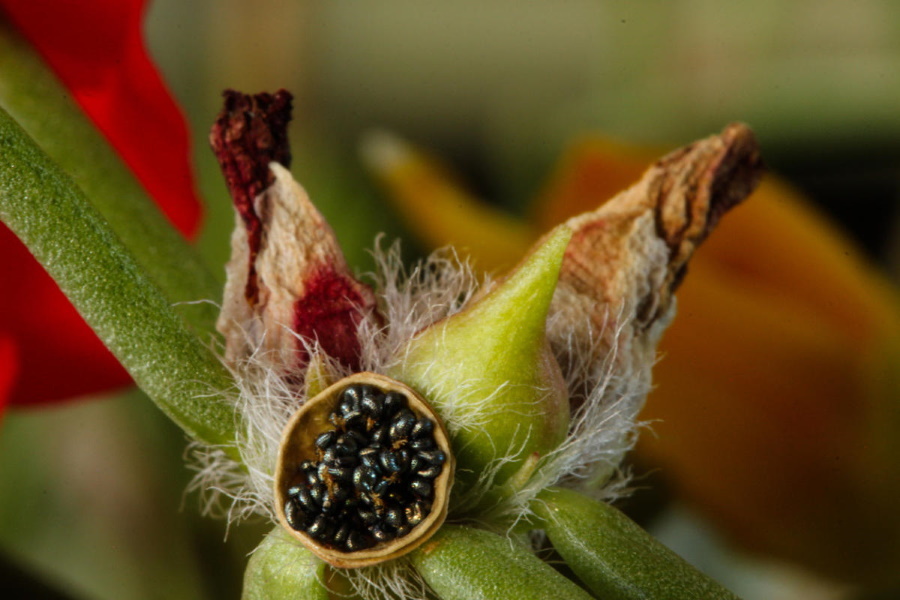
There are a large number of small seeds inside the purslane capsule.
If purslane is grown in the garden, and not as part of the compositions, then it is sown beautifully by itself, shooting seeds when they are ripe.

Purslane reproduces well by cuttings. To do this, you need to cut the stems about 5 cm long, remove the lower leaves and plant the cuttings in the ground
Only garden and vegetable varieties are used for food, the rest are bred as decorative flowers to delight lovers with their flowering.
Video: Growing and caring for purslane
Photo of garden compositions in a flowerbed with other flowers



